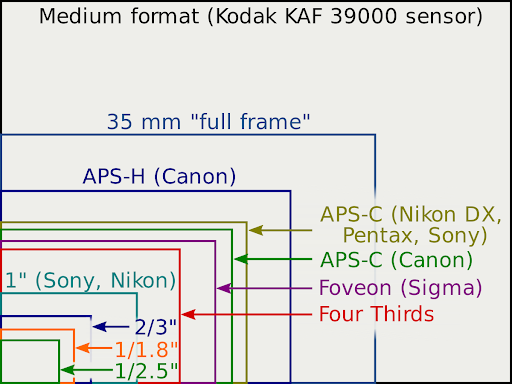Camera Sensor Size Differences
The choice between full-frame and crop sensor cameras is a crucial decision for photographers, with each option offering distinct advantages and trade-offs. Full-frame sensors, measuring 36mm x 24mm, provide a wider field of view and superior low-light performance, while crop sensors, such as APS-C (around 22.5mm x 15mm) and Micro Four Thirds (approximately 18mm x 13.5mm), offer increased reach and more compact, affordable systems. Understanding these differences is essential for selecting the right camera for your photographic needs and budget.
Sensor Size Impact
The physical size of the camera sensor has significant impacts on various aspects of photography. This table summarizes the key differences between full-frame and crop sensors:
| Aspect | Full-Frame Sensor | Crop Sensor |
|---|---|---|
| Sensor Size | 36mm x 24mm | APS-C: ~22.5mm x 15mm, Micro Four Thirds: ~18mm x 13.5mm |
| Field of View | Wider | Narrower (1.5x-2x crop factor) |
| Low-Light Performance | Better | Generally lower |
| Depth of Field | Shallower at equivalent apertures | Deeper at equivalent apertures |
| Dynamic Range | Typically higher | Generally lower |
| Noise Performance | Better, especially at high ISOs | More noise, especially at high ISOs |
| Camera Size | Larger, heavier | Smaller, lighter |
| Cost | More expensive | More affordable |
| Lens Compatibility | Requires full-frame lenses | Can use both full-frame and crop-specific lenses |
The larger sensor size of full-frame cameras allows for more light capture, resulting in better low-light performance and dynamic range [1] [2]. This is due to the larger individual pixels on full-frame sensors, which can gather more light information.
The crop factor of smaller sensors affects the effective focal length and field of view of lenses. For example, a 50mm lens on an APS-C camera with a 1.5x crop factor will have an effective focal length of 75mm compared to a full-frame camera [4]. Crop sensors offer advantages in terms of increased reach for telephoto photography, as the crop factor effectively extends the focal length of lenses [2] [5].
However, achieving shallow depth of field can be more challenging with crop sensors. To match the depth of field of a full-frame camera, crop sensor users need to use wider apertures or longer focal lengths. For instance, to achieve the same depth of field as an f/4 aperture on a full-frame camera, an APS-C camera with a 1.5x crop factor would need to use an aperture of approximately f/2.7 [7].
It's important to note that while full-frame sensors generally offer superior image quality, modern crop sensor cameras have made significant advancements in technology, narrowing the gap in performance for many shooting scenarios [6].
Depth of Field Differences
Larger full-frame sensors allow for shallower depth of field, making it easier to isolate subjects from the background - a desirable effect in portrait photography. Crop sensors, on the other hand, tend to produce a deeper depth of field at equivalent apertures, which can be advantageous for landscape and group shots where more of the image needs to be in focus [1] [2]. To achieve the same depth of field as a full-frame camera, crop sensor users need to adjust their aperture by the crop factor. For instance, an f/4 aperture on a full-frame camera would require an f/2.8 aperture on an APS-C camera with a 1.5x crop factor to produce a similar depth of field effect.
Noise and Image Quality
Noise and image quality are crucial factors that differentiate full-frame and crop sensor cameras. Full-frame sensors generally offer superior performance in these areas due to their larger physical size and pixel dimensions. Full-frame sensors typically have larger individual pixels (photosites) compared to crop sensors with the same megapixel count. These larger pixels can capture more light, resulting in better signal-to-noise ratios, especially in low-light conditions [1] [2].
This means that full-frame cameras can produce cleaner images with less visible noise at higher ISO settings. For example, a full-frame camera might produce acceptable images at ISO 6400 or even 12800, while a crop sensor camera may start showing significant noise at ISO 3200 or 6400 [3].
Full-frame sensors also tend to have a wider dynamic range, meaning they can capture a broader spectrum of light and dark tones in a single exposure [4]. This results in images with more detail in both highlight and shadow areas, providing greater flexibility in post-processing.
However, it's important to note that modern crop sensor cameras have made significant advancements in noise reduction and image processing technologies. High-end APS-C cameras can produce excellent image quality that rivals full-frame cameras in many situations, especially at lower ISO settings [5].
The difference in image quality becomes more apparent in challenging lighting conditions or when making large prints. Full-frame cameras generally maintain their advantage in these scenarios, producing images with finer detail, smoother tonal gradations, and better color accuracy [6].
Ultimately, while full-frame sensors have an inherent advantage in noise performance and image quality, the practical difference may not be significant for many photographers, especially those shooting in good lighting conditions or primarily sharing images digitally [7].
Cost and Lens Compatibility
Full-frame cameras and lenses typically come with a higher price tag due to their larger sensors and more complex manufacturing processes. In contrast, crop sensor systems offer a more budget-friendly entry point for photographers. Lens compatibility varies between the two formats: full-frame cameras require full-frame lenses for optimal performance, while crop sensor cameras can use both full-frame and crop-specific lenses [1] [2].
However, using full-frame lenses on crop sensors results in a narrower field of view due to the crop factor, which can be advantageous for telephoto applications but limiting for wide-angle photography [3].

Comments
Post a Comment